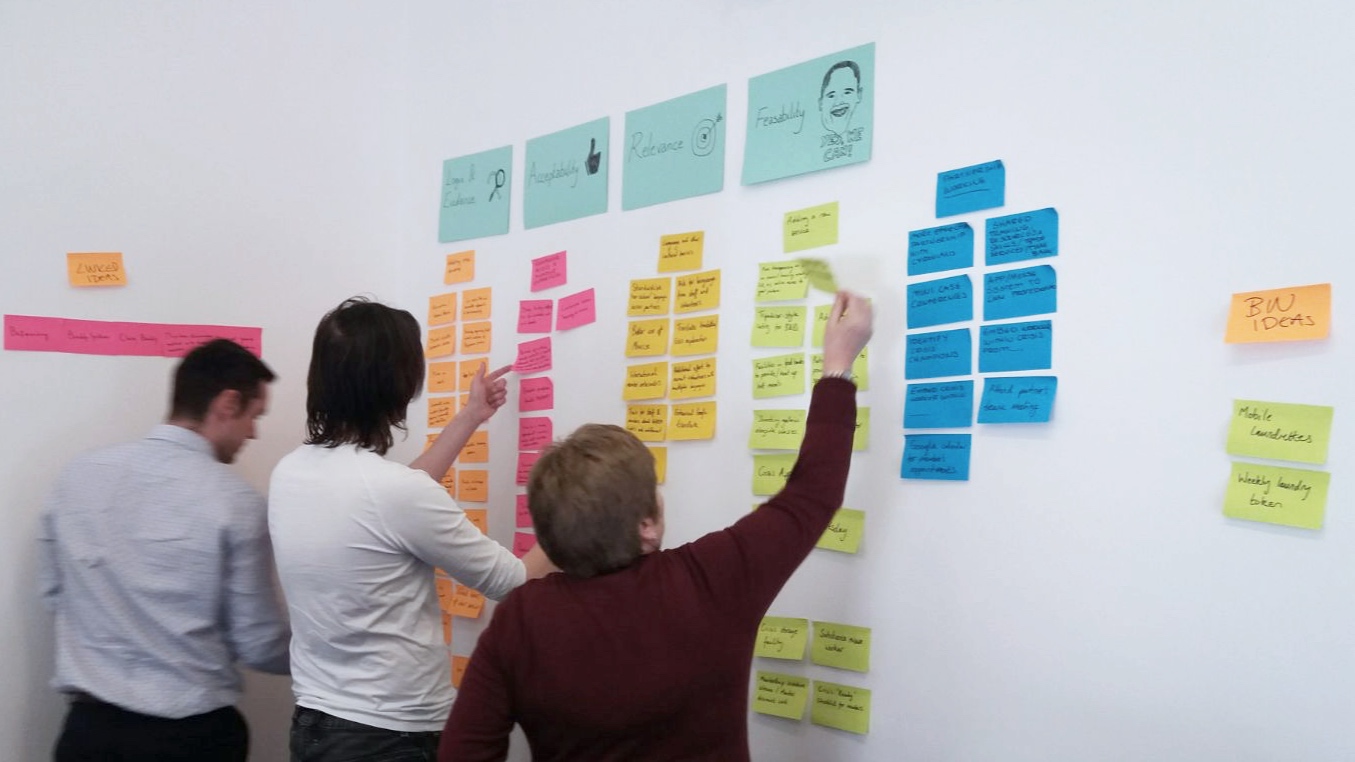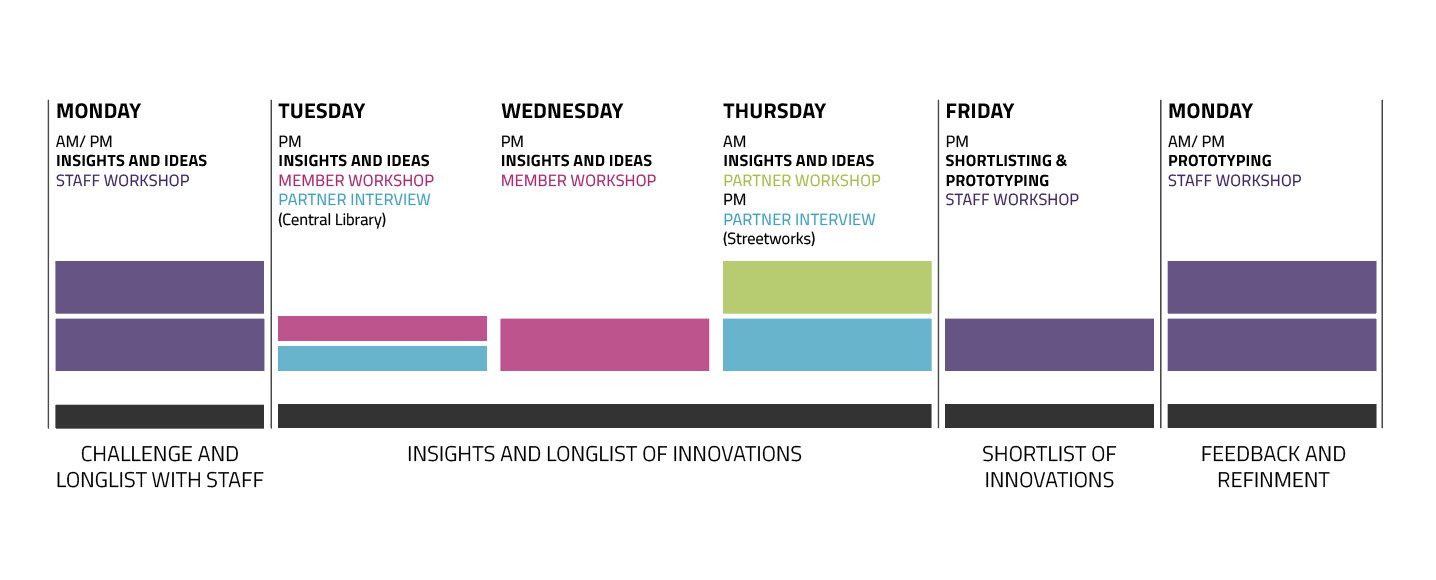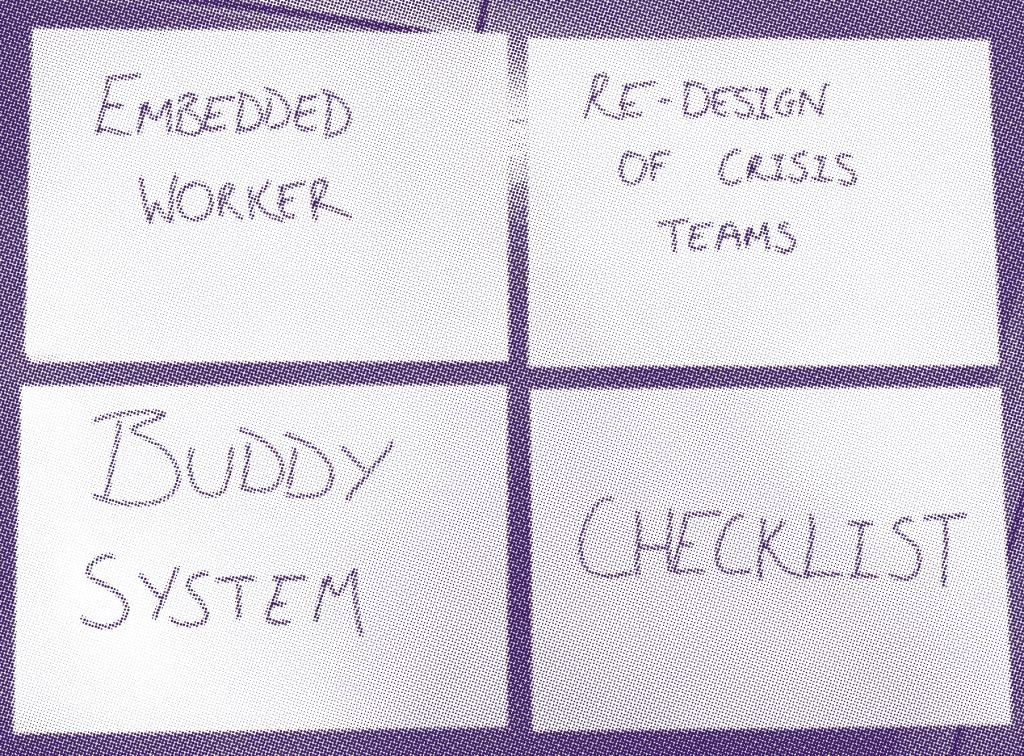Running a marathon as a sprint: service design accelerated
Ben Hartridge | Researcher | @benhartridge
Ben Hartridge researcher at the Dartington Service Design Lab, reflects on an improbable hour that distils the essence of a Lab Service Design Sprint.
Ann, Mike and Simon, staff from the charity Crisis, stand squinting at the eighty post-it notes that cover the wall. We’re gathered in a conference room in central Glasgow and outside it’s one of those perfectly bright and crisp late winter’s days. In a little over an hour’s time, the eighty notes will have been whittled down to four. Except it’s hard to believe that’s possible right now.
It’s Friday, the pivotal fifth day of a seven-day Service Design Sprint that a small team from the Dartington Service Design Lab (the Lab) – Kate Tobin, Maria Portugal and myself – are running for Crisis, the national homelessness charity.
A Design Sprint is a method popularised by Google Ventures – Google’s investment arm – for making rapid progress on the knottiest challenges faced by the start-ups in which they’ve invested. We at the Lab, alongside numerous other service design agencies, have borrowed this idea from the world of tech start-ups to help charities and government agencies improve their services for vulnerable children, families and adults.
Crisis offer a range of one-to-one support and group activities to help individuals find a sustainable route out of homelessness. Crisis Skylight Edinburgh, the charity’s base in the Scottish capital, have a particular challenge lined up for their Sprint.
How can we increase the quality of member engagement, especially those with complex needs?
Members are those who access and sign up to use the Crisis services: people who are at risk of homelessness, who are currently homeless, or who have been homeless in the last two years. Crisis’s data shows they need to drive deeper and longer engagement with users, particularly those facing multiple adverse circumstances.
Each of the eighty post-it notes gathered on the wall describe, in three or four words, an idea for a new service or an adaption to Crisis Skylight Edinburgh’s existing service that could help the Skylight answer this challenging question. The colourful patchwork captures all the work of the previous four days of the Service Design Sprint, when the Lab team facilitated seven workshops with Crisis’ staff, key partners and members with current or recent experience of homelessness totalling around 60 people over the course of the week. During these sessions – a mix of discussion and structured activities – we collected a huge longlist of ideas.
A key difference between our approach to a Sprint and the Google Ventures model is that we involve a range of stakeholders – most importantly service users – at the longlisting stage. Google Sprints involve a small team of software engineers, marketing managers and company executives designing a solution that is subsequently tested with users (or customers). In contrast, we bring frontline staff who deliver the service, service users and key partners into the room at the design stage. We do this for two reasons.
Services are not like tech products. The human connection is an important element of support services provided by charities like Crisis, so in order to design a service that works, you need to get those who deliver and receive the service in the room together.
Services are part of a wider complex system. There are public and voluntary agencies out there providing services to vulnerable people and unlike competitive private companies they work best when they work together and are aware of their role in the wider system.
If you’re interested in how our service design work sits at the intersection between human-centred design, systems thinking and the use of high-quality data and evidence, check out this blog by Tim Hobbs, the Lab’s Director.
But right now, back in the sunlit conference room, we’ve got a job to do. Kate Tobin, one of the Lab’s Service Design Specialists, has just briefed Ann, Mike and Simon on the four criteria they should apply to the longlist of ideas to narrow it down to a final four.
Once these principles are established, the flag drops and the team of three are let loose on the wall of post-its. For a moment, there’s a hesitation. Where do we even begin…? But then, they’re off. Simon starts clustering similar ideas together. Ann begins methodically working through the post-its from right to left, removing the ideas that don’t make the cut. Mike is on hand to explain any of the ideas that aren’t clearly articulated by the few words written on the post-it. He’s one of Crisis’ one-to-one coaches and he’s attended all the workshops of the Sprint so far.
This is why the daunting task of cutting eighty ideas down to four in no more than an hour is possible: because we have exactly the right people in the room. Mike is the common thread running through the whole process; he’s seen each and every idea as it’s emerged from workshops with staff, members and partners. Ann, the Director of Crisis Skylight Edinburgh with strategic oversight, and Simon, who manages Crisis’ class-based and group work in the city compliment Mike’s experience delivering one-to-one support and bring years of experience working in homelessness. The Lab injected logic and evidence into the process thanks to our critical challenge, position as outsiders and our experience and knowledge of evidence-based practice.
It’s always difficult to assess whether an idea will work, but these guys have a better chance than anyone. The short timeframe focuses their minds on the decision to cut or keep each idea. And sure enough, before the hour is up where once there was an intimidating wall of colour, we’re now looking at four neat clusters of post-its. Kate grabs a sharpie and four pieces of card and scribbles down a name on each that captures the idea behind each cluster.
Result. Ann, Mike and Simon can’t believe how painless the task was, but really, they had the skills and expertise to complete it. This short episode distils the essence of a Service Design Sprint. The right people with the right tools devoting an intense focus on a challenge that they all agree is a vital one.
During the final session of the Sprint the following Monday, the Lab team presented the shortlisted ideas back to the Crisis staff in Edinburgh. The group’s critical push and creative steer shaped these ideas into more fully formed prototypes from which the group elected their preferred option.
And the Sprint is only the start. Over the coming months, the next stage of the project will see Crisis Skylight Edinburgh implementing the idea they devised during the Service Design Sprint. The Lab will bring our fifty years of experience as scientists and researchers to bear on the challenge of rigorously testing the idea through a process of Rapid Cycle Testing.
You can find out more about the Lab’s work with Crisis – the Hothouses for Innovation project – on the project page on our website.




